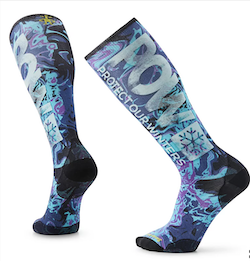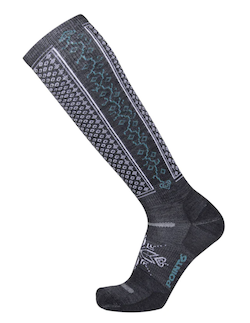Let’s be honest: ski socks aren’t the most exciting piece of ski gear. They don’t have the excitement of skis or boots, or even the wow factor you get from a new jacket or pants. But don’t let that fool you. Ski socks are much more important than you might think. After all, we spend hundreds of dollars on ski boots, dialing in the fit until it’s oh-so-right. But if your socks aren’t right, all that dialing in could be for nothing; your boots won’t be able to do the job they’re supposed to, you’ll be plenty uncomfortable, and your skiing will suffer. So yay, let’s hear it for socks!
Today I want to talk about what you need to consider when you buy ski socks. Because really, even though there are tons of ski socks available, not just any sock will do.

Smartwool Ski Zero Cushion POW Print Over the Calf Ski Socks
Thickness
As you can imagine, ski socks come in a variety of thicknesses: heavy, mid-weight, and thin. Some offer cushioning in various places — like at the shin or toe — and some don’t. Obviously, the thickness you choose is a matter of preference. That said, thicker socks are not necessarily warmer. It might sound counterintuitive, but thinner socks will keep your feet warmer and more comfortable. Why? Bulky socks can bunch up, interfere with the fit of your boot, and reduce circulation to make your feet feel colder. A sock that bunches up can also cause hot spots or blisters, which can be pretty painful. I always, always opt for thin socks. I recommend you do, too.
Materials
Merino Wool
Merino wool comes from a specific breed of sheep prized for its high quality wool. Things made of merino wool usually aren’t cheap, but the higher cost can be well worth it. Merino wool is known for being soft, warm, breathable, and very comfortable. It also wicks moisture extremely well, breathes better than most synthetics, and is naturally anti-bacterial for outstanding odor resistance. That said, Merino socks are rarely made of 100% Merino wool. Most are made using a blend of fabrics that include nylon for durability and elastane or spandex for unrestricted mobility; this helps your socks keep their shape and provides a supportive fit.

Point6 Norwegian Ultra Light OTC Ski Sock
Synthetic
If the high cost of merino wool doesn’t thrill you, there are always synthetics. These are are made from materials like nylon, acrylic, and polyester. Today’s synthetics typically feature fibers that trap warmth and wick moisture, giving them many of the characteristics that are naturally found in wool. Some also
come with an antimicrobial coating for odor control. In general, synthetic socks are lighter, cheaper, and faster drying than wool socks.
Cotton
Don’t even go there. Cotton absorbs and holds onto water like a sponge, causing your feet to feel uncomfortably wet and cold. So do yourself a favor: pass on cotton, at least for skiing.
Other things to consider
Fit: Make sure the sock you choose fits snuggly around your toes, ankles, and shins. This keeps it from moving around or bunching up, which can cause issues like hot spots, chafing, or blisters. However, be careful not to choose a sock that’s too tight, either. You want enough room to wiggle your toes and flex your foot, but not enough to cut off circulation.
People who are prone to cold feet or who suffer from poor circulation might even want to consider compression socks, which can help increase blood flow to the feet to make them warmer.
You also want to make sure the socks have flat or integrated seams. Raised seams can cause blisters or irritation, two things you want to avoid.
Length: Most ski socks go up to the knee. Not only is this warmer and more comfortable, but it helps prevent shin bang, which can occur when the front of the boot hits or puts painful pressure on the front of the leg.
One pair or two? When it’s really cold, resist the temptation to pull on an extra layer of socks. An extra pair can take up too much space in your boots, restricting blood flow and actually making your feet colder. Also, the two pairs can rub together, irritating your skin and causing blisters.
Heated socks! I’d be remiss if I didn’t include heated socks in this piece. These use tiny battery packs that slide into small pouches on the sides of the socks, along with heating elements that are integrated into the sock’s material. Some even offer a remote control to turn the heat on and off or adjust the heat settings. I’ve never tried them, so I can’t say if they’d work better than the heated footbeds I currently use in my boots. Some people say they’re a game changer, though, so it could be worth checking out.
Good ski socks are a treasure, and really, when you consider the cost of all your other ski gear, they’re pretty inexpensive, too. Get yourself a good pair. Your feet will be happy, and you’ll be happy, too.
